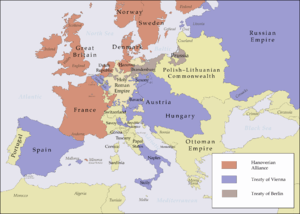Treaty of Hanover (1725)

Coalitions in Europe between 1725 and 1730. Signatories of the Treaty of Vienna (April 30, 1725) in blue and signatories of the Treaty of Hanover (September 3, 1725) in red. Prussia, in brown, first joined the Hanoverian Alliance, but later changed sides after the Treaty of Berlin on December 23, 1728.[1]
The Treaty of Hanover was developed in response to the Treaty of Vienna (April 30, 1725) in which King Philip V of Spain allied himself with Habsburg Austria after his daughter's engagement to Louis XV of France was broken off. This accord was concluded by Great Britain, France and Prussia on September 3, 1725. George I, growing concerned about a potential conflict with Spain, signed the agreement linking France, Prussia, and the Netherlands (later acceded) together in opposition to Spain.[1][2]
References
- Bibliography
- Anisimov, E.V. (1993). "The imperial heritage of Peter the Great in the foreign policy of his early successors". In Ragsdale, Hugh. Imperial Russian Foreign Policy (reprint ed.). Cambridge University Press. ISBN 9780521442299.
- Kohn, George C., ed. (2006). "Anglo Spanish War of 1727-29". Dictionary of Wars (3rd ed.). Infobase Publishing. ISBN 9781438129167.
This article is issued from Wikipedia - version of the 10/25/2015. The text is available under the Creative Commons Attribution/Share Alike but additional terms may apply for the media files.